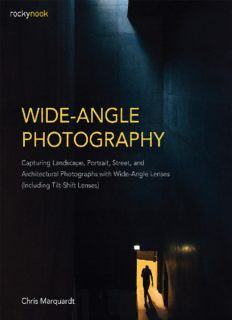Table Of ContentChris Marquardt
Wide-Angle Photography
Capturing Landscape, Portrait, Street, and Architectural
Photographs with Wide-Angle Lenses
(Including Tilt-Shift Lenses)
Wide-Angle Photography Chris Marquardt
www.chrismarquardt.com
Editor: Joan Dixon
Translation: Jeremy Cloot
Interior design: Birgit Bäuerlein
Layout production: Hespenheide Design Cover design: Hespenheide Design
Illustrations: Peter Marquardt
Project manager: Lisa Brazieal
Marketing coordinator: Mercedes Murray ISBN: 978-1-68198-383-7
1st Edition (1st printing, August 2018) All images © Chris Marquardt unless otherwise noted ©
2018 by dpunkt.verlag, GmbH, Heidelberg, Germany Original German title: Weitwinkelfotografie
German ISBN: 978-3-86490-398-2
Translation copyright © 2018 by Rocky Nook, Inc. All rights reserved Rocky Nook, Inc.
1010 B Street, Suite 350
San Rafael, CA 94901
USA
www.rockynook.com
Distributed in the U.S. by Ingram Publisher Services Distributed in the UK and Europe by
Publishers Group UK
Library of Congress Control Number: 2017963021
All rights reserved. No part of the material protected by this copyright notice may be reproduced or
utilized in any form, electronic or mechanical, including photocopying, recording, or by any
information storage and retrieval system, without written permission of the publisher.
Many of the designations in this book used by manufacturers and sellers to distinguish their
products are claimed as trademarks of their respective companies. Where those designations
appear in this book, and Rocky Nook was aware of a trademark claim, the designations have been
printed in caps or initial caps. All product names and services identified throughout this book are
used in editorial fashion only and for the benefit of such companies with no intention of
infringement of the trademark. They are not intended to convey endorsement or other affiliation
with this book.
While reasonable care has been exercised in the preparation of this book, the publisher and author
assume no responsibility for errors or omissions, or for damages resulting from the use of the
information contained herein or from the use of the discs or programs that may accompany it.
This book is printed on acid-free paper.
Printed in China
For everyone who is interested
in the why as well as the how.
Acknowledgments
I would like to thank everyone who took part in the first 24mm workshop.
Without you this book wouldn’t exist. Thanks also go to Jim Rakete for his
early influences and for completing the circle; to the Feelin’ Good
Bluesband (Martin Kade, Stefan Zenner, Nick Deeg, and Hans Madlinger);
Hellmut Hattler; Joo Kraus; Tales in Tones (Ralf Schmid, Veit Hübner,
Torsten Krill); Douglas Hopkins for his beautiful images; Ralf Albert for
his Frankfurt views; Alexa and Alexander Waschkau for their positive
radiance; Ralf Hüls and Boris Nienke for valuable information; Tim
Vollmer for the exciting locations; Peter Marquardt for nighttime lines;
Marieke Thüne for making contacts; Elisabeth File for freezing patiently;
Paul Kelly for the low-level tripods; Richard PJ Lambert for his solar
images; Jochen Möller for his hands; 11A for the pretty rear wall. And
thanks to Moni for everything else . . . and the empty table.
About the Author
Photo: Pax Ahimsa Gethen
In 2005, I swapped my full-time job for the world of freelance
photography. Back then, the relatively new phenomenon called podcasting
helped me gain a foothold and find out more about the things I really like
to do. In my life as a photographer and photo coach I get to meet many
interested and interesting people, and travel with them to the end of the
world or, sometimes, just to the next village. At home in the View-finder
Villa 1[1], there is a constant stream of people who turn up to learn about
photography in our many workshops. Topics include composition, dealing
with human subjects, and light in general. More exotic topics such as
analog large-format photography, photography using film, and the
psychology of photography are also covered. For more details about my
workshops and photo tours, visit www.discoverthetopfloor.com.
As a passionate podcaster, I regularly explain how photography works.
Every week, my podcast at www.tipsfromthetopfloor.com covers a broad
range of photographic topics as well as answers to listeners’ questions.
For a look into the future, visit www.thefutureofphotography.com, where
my friend Adrian Stock and I explore the exciting ways new and emerging
technologies will shape photography in the years to come.
As a consultant, I advise companies on how to improve their visual image
by concentrating on human perception, the basics of great design, and the
ways in which images affect various target audiences.
As a producer, I help companies and individuals to convert their ideas into
customized images and video.
As a traveler, I help others to travel successfully, either in person or
through the images and stories I bring back from my own journeys. Check
out my podcasts or other online resources for more details.
Finally, as an author, I can delve much deeper into my favorite topics than
my workshops allow. Check out the book The Film Photography Handbook,
written with my partner Monika Andrae and published by Rocky Nook, Inc.
For more details on all of my activities, visit www.chrismarquardt.com.
1 Throughout the book, these bracketed numbers refer to a list of websites found in the References
section of the appendices.
Table of Contents
Preface: Depth Follows Breadth
How to Approach This Book
Who is This Book Aimed At?
Photospeak
1 First Steps
1.1 Differences in Depth
1.2 Angles of View and Context
1.3 Sharpness and Context
1.4 Landscapes and Composition
1.5 Barrel Distortion
1.6 Using Depth and Distortion Creatively
1.7 Distortion at the Edge of the Frame
2 What Are Wide Angles All About?
2.1 The Human Eye
2.2 Focal Lengths
2.2.1 Normal Lenses
2.2.2 Depth not Breadth
2.2.3 Crop Factors
2.2.4 Classifying Focal Lengths
2.3 Angles of View
2.4 Perceived Wide Angles
Description:The very thing that makes wide-angle photography so compelling also makes it a challenge: While you’re sure to capture a vast scene using a wide-angle lens, it can be difficult to direct the viewer’s attention when so many elements are included in an image. For many photographers, the results of

